Sustainable Energy Report
VerifiedAdded on 2020/12/09
|15
|4376
|69
Report
AI Summary
This report examines the current state of solar thermal technology in the UK, analyzing its impact on the energy system and other fuels. It examines technical developments, barriers to implementation, and opportunities for growth. The report also includes a personal view on the technology and its potential for a sustainable future. Desklib provides past papers and solved assignments for students.
Contribute Materials
Your contribution can guide someone’s learning journey. Share your
documents today.
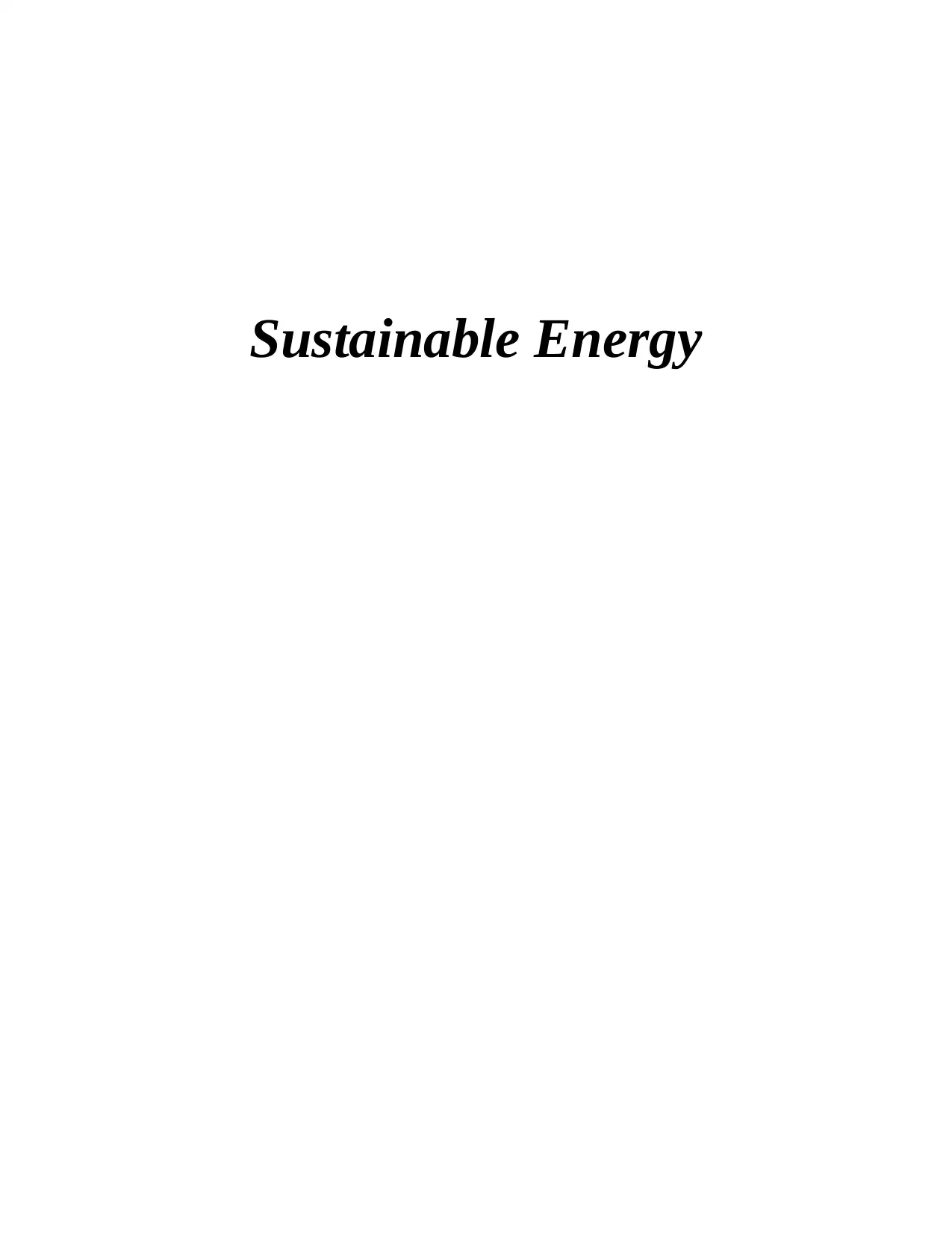
Sustainable Energy
Secure Best Marks with AI Grader
Need help grading? Try our AI Grader for instant feedback on your assignments.
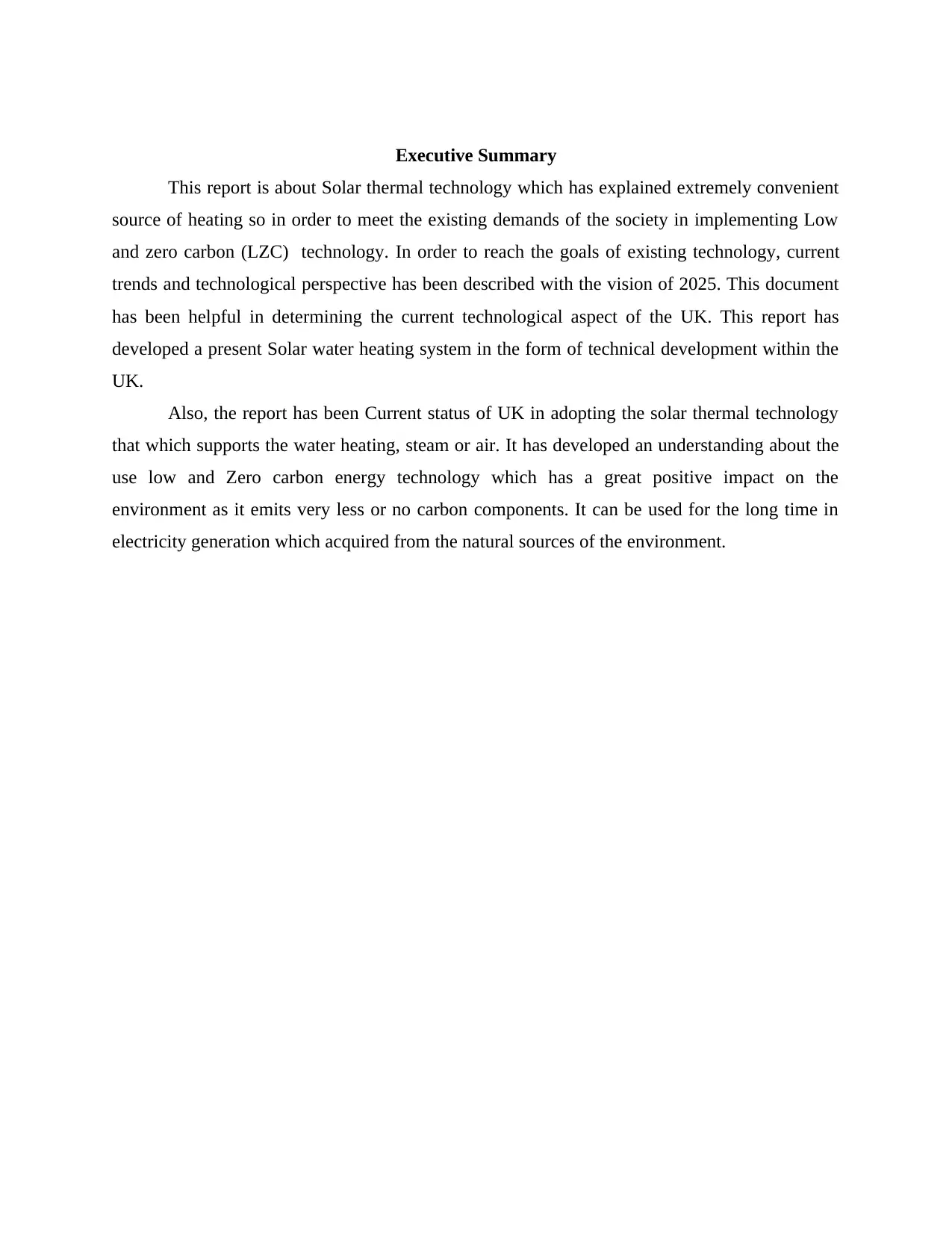
Executive Summary
This report is about Solar thermal technology which has explained extremely convenient
source of heating so in order to meet the existing demands of the society in implementing Low
and zero carbon (LZC) technology. In order to reach the goals of existing technology, current
trends and technological perspective has been described with the vision of 2025. This document
has been helpful in determining the current technological aspect of the UK. This report has
developed a present Solar water heating system in the form of technical development within the
UK.
Also, the report has been Current status of UK in adopting the solar thermal technology
that which supports the water heating, steam or air. It has developed an understanding about the
use low and Zero carbon energy technology which has a great positive impact on the
environment as it emits very less or no carbon components. It can be used for the long time in
electricity generation which acquired from the natural sources of the environment.
This report is about Solar thermal technology which has explained extremely convenient
source of heating so in order to meet the existing demands of the society in implementing Low
and zero carbon (LZC) technology. In order to reach the goals of existing technology, current
trends and technological perspective has been described with the vision of 2025. This document
has been helpful in determining the current technological aspect of the UK. This report has
developed a present Solar water heating system in the form of technical development within the
UK.
Also, the report has been Current status of UK in adopting the solar thermal technology
that which supports the water heating, steam or air. It has developed an understanding about the
use low and Zero carbon energy technology which has a great positive impact on the
environment as it emits very less or no carbon components. It can be used for the long time in
electricity generation which acquired from the natural sources of the environment.
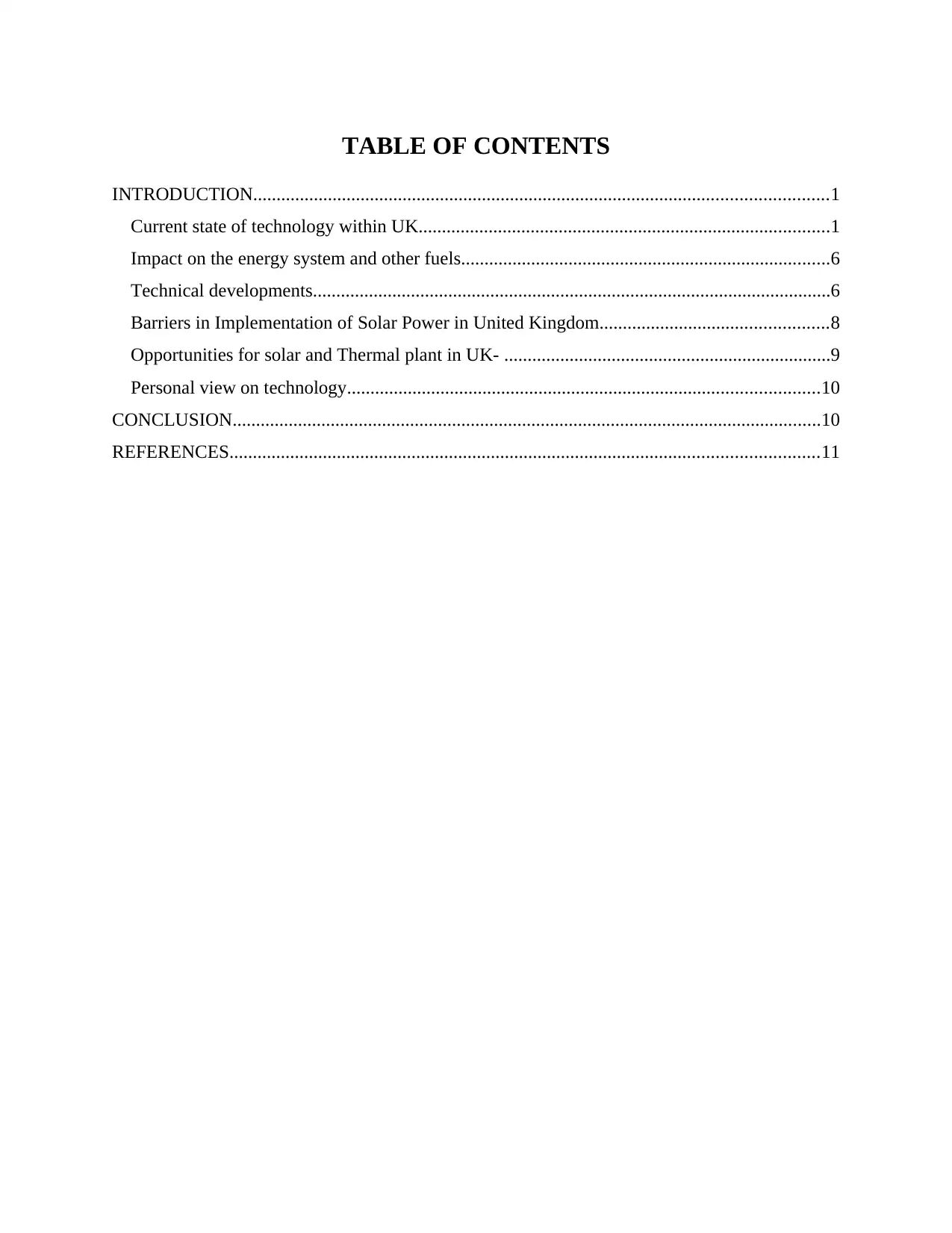
TABLE OF CONTENTS
INTRODUCTION...........................................................................................................................1
Current state of technology within UK........................................................................................1
Impact on the energy system and other fuels...............................................................................6
Technical developments...............................................................................................................6
Barriers in Implementation of Solar Power in United Kingdom.................................................8
Opportunities for solar and Thermal plant in UK- ......................................................................9
Personal view on technology.....................................................................................................10
CONCLUSION..............................................................................................................................10
REFERENCES..............................................................................................................................11
INTRODUCTION...........................................................................................................................1
Current state of technology within UK........................................................................................1
Impact on the energy system and other fuels...............................................................................6
Technical developments...............................................................................................................6
Barriers in Implementation of Solar Power in United Kingdom.................................................8
Opportunities for solar and Thermal plant in UK- ......................................................................9
Personal view on technology.....................................................................................................10
CONCLUSION..............................................................................................................................10
REFERENCES..............................................................................................................................11

INTRODUCTION
Sustainable energy can be termed as the principle in which human use of energy meets
the present needs without compromising the ability of future generation to meet the own needs.
Sustainable energy technologies are deployed to generate electricity, to heat or cool the
buildings along with the power transportation system and machines. This report will be based on
low and Zero carbon technologies (LZC) which do not harm the environment. So this study will
help in making a clear understanding about the Solar technology for building and this type of
LZC sourced technology generally is generally cost effective way to generate energy.
In addition to this, absorption cooling is a technology that uses heat instead of electricity
in order to produce a cooling effect. This document will explore the Current state of technology
within UK and enhance the knowledge of the reader about impact of energy system and other
fuels. In the present report, various future and present technical developments will also be
described. Along with this, barriers in employing LZC within the particular area and
opportunities will also be described for the further understanding.
Current state of technology within UK
Low and Zero carbon technologies are the one that emits low level of Carbon dioxide or
may responsible for zero CO2 emission. So, Solar thermal technologies for building which is
used to provide the heat for the building, emitting low or no net CO2 emission ( Chu and
Majumdar, 2016). The solar record is the latest in string of landmark achievements for the UK's
power system. Moreover, the entire solar thermal technological system is beneficial in terms of
maintaining the environment and also it is very easy to implement and has low maintenance
costings. Thus, UK is pledged to use solar power thermal plant and minimise the use of coal by
the year 2025. Solar thermal energy can be captured by Solar panels so there are two main types
of solar panels which uses the sun energy to generate power. Solar water heating collectors are
the panels that absorb energy from the sun and transfer it to heat water. However, it can be
identified that solar represents only small part of the electricity production in UK until 2010's
when it was rapidly increased. Current state of the solar thermal technology within UK is
described below along with various statistic figures in order to determine the actual current
position of Country in using the sustainable energy.
In 2016, UK has passed another milestone which helped the region in generating more
electricity then Coal. The UK government have realised that solar thermal technology
1
Sustainable energy can be termed as the principle in which human use of energy meets
the present needs without compromising the ability of future generation to meet the own needs.
Sustainable energy technologies are deployed to generate electricity, to heat or cool the
buildings along with the power transportation system and machines. This report will be based on
low and Zero carbon technologies (LZC) which do not harm the environment. So this study will
help in making a clear understanding about the Solar technology for building and this type of
LZC sourced technology generally is generally cost effective way to generate energy.
In addition to this, absorption cooling is a technology that uses heat instead of electricity
in order to produce a cooling effect. This document will explore the Current state of technology
within UK and enhance the knowledge of the reader about impact of energy system and other
fuels. In the present report, various future and present technical developments will also be
described. Along with this, barriers in employing LZC within the particular area and
opportunities will also be described for the further understanding.
Current state of technology within UK
Low and Zero carbon technologies are the one that emits low level of Carbon dioxide or
may responsible for zero CO2 emission. So, Solar thermal technologies for building which is
used to provide the heat for the building, emitting low or no net CO2 emission ( Chu and
Majumdar, 2016). The solar record is the latest in string of landmark achievements for the UK's
power system. Moreover, the entire solar thermal technological system is beneficial in terms of
maintaining the environment and also it is very easy to implement and has low maintenance
costings. Thus, UK is pledged to use solar power thermal plant and minimise the use of coal by
the year 2025. Solar thermal energy can be captured by Solar panels so there are two main types
of solar panels which uses the sun energy to generate power. Solar water heating collectors are
the panels that absorb energy from the sun and transfer it to heat water. However, it can be
identified that solar represents only small part of the electricity production in UK until 2010's
when it was rapidly increased. Current state of the solar thermal technology within UK is
described below along with various statistic figures in order to determine the actual current
position of Country in using the sustainable energy.
In 2016, UK has passed another milestone which helped the region in generating more
electricity then Coal. The UK government have realised that solar thermal technology
1
Secure Best Marks with AI Grader
Need help grading? Try our AI Grader for instant feedback on your assignments.
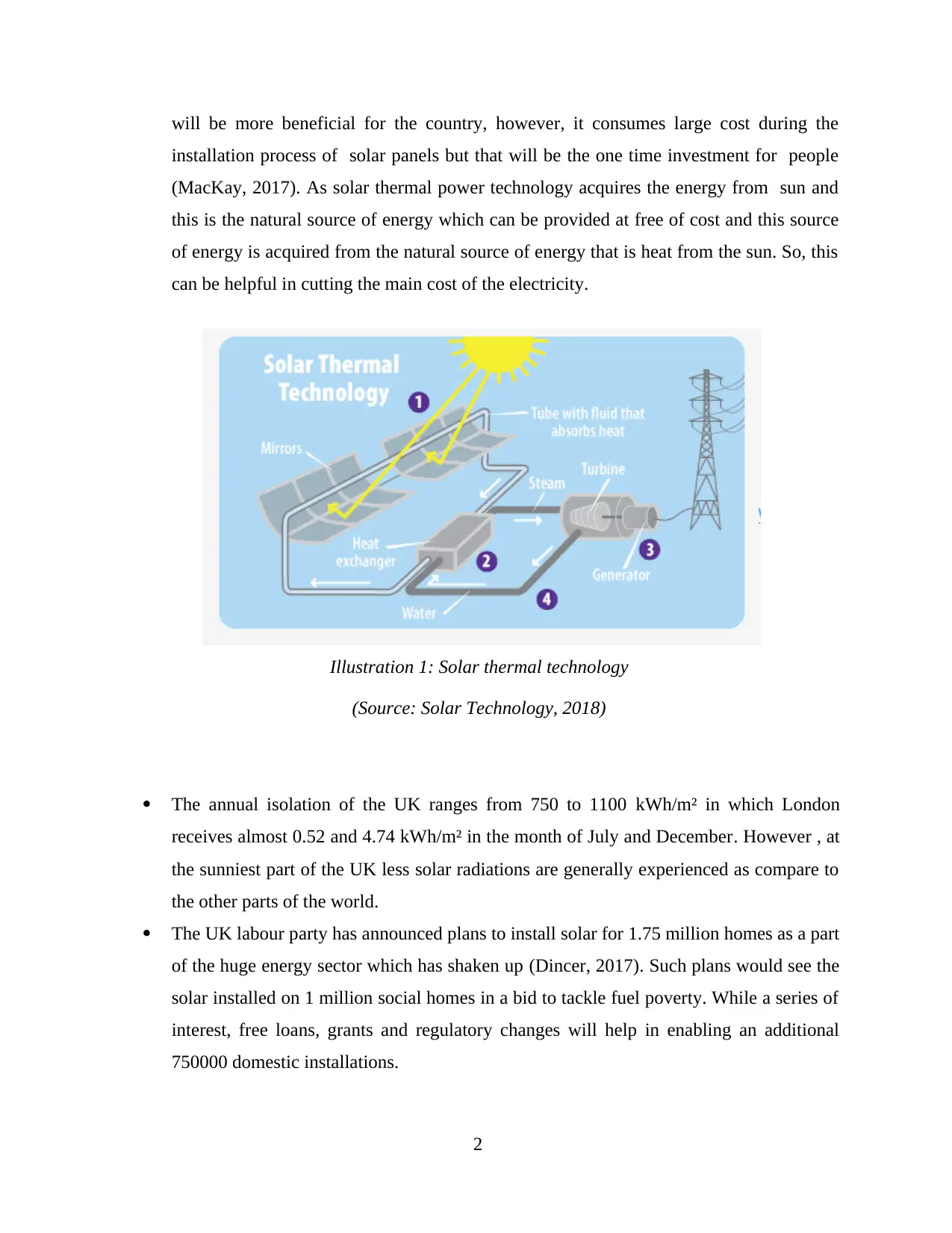
will be more beneficial for the country, however, it consumes large cost during the
installation process of solar panels but that will be the one time investment for people
(MacKay, 2017). As solar thermal power technology acquires the energy from sun and
this is the natural source of energy which can be provided at free of cost and this source
of energy is acquired from the natural source of energy that is heat from the sun. So, this
can be helpful in cutting the main cost of the electricity.
The annual isolation of the UK ranges from 750 to 1100 kWh/m² in which London
receives almost 0.52 and 4.74 kWh/m² in the month of July and December. However , at
the sunniest part of the UK less solar radiations are generally experienced as compare to
the other parts of the world.
The UK labour party has announced plans to install solar for 1.75 million homes as a part
of the huge energy sector which has shaken up (Dincer, 2017). Such plans would see the
solar installed on 1 million social homes in a bid to tackle fuel poverty. While a series of
interest, free loans, grants and regulatory changes will help in enabling an additional
750000 domestic installations.
2
Illustration 1: Solar thermal technology
(Source: Solar Technology, 2018)
installation process of solar panels but that will be the one time investment for people
(MacKay, 2017). As solar thermal power technology acquires the energy from sun and
this is the natural source of energy which can be provided at free of cost and this source
of energy is acquired from the natural source of energy that is heat from the sun. So, this
can be helpful in cutting the main cost of the electricity.
The annual isolation of the UK ranges from 750 to 1100 kWh/m² in which London
receives almost 0.52 and 4.74 kWh/m² in the month of July and December. However , at
the sunniest part of the UK less solar radiations are generally experienced as compare to
the other parts of the world.
The UK labour party has announced plans to install solar for 1.75 million homes as a part
of the huge energy sector which has shaken up (Dincer, 2017). Such plans would see the
solar installed on 1 million social homes in a bid to tackle fuel poverty. While a series of
interest, free loans, grants and regulatory changes will help in enabling an additional
750000 domestic installations.
2
Illustration 1: Solar thermal technology
(Source: Solar Technology, 2018)
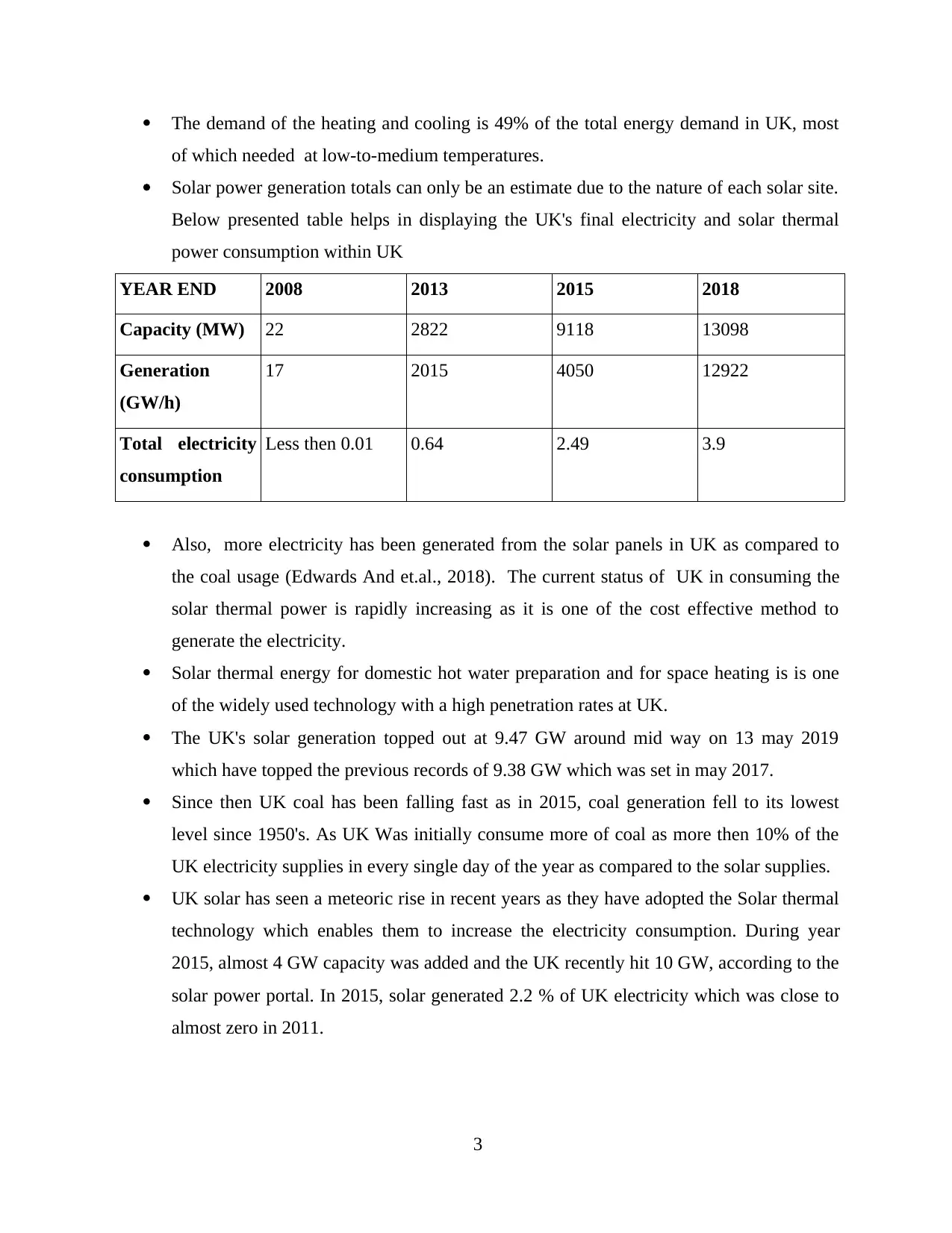
The demand of the heating and cooling is 49% of the total energy demand in UK, most
of which needed at low-to-medium temperatures.
Solar power generation totals can only be an estimate due to the nature of each solar site.
Below presented table helps in displaying the UK's final electricity and solar thermal
power consumption within UK
YEAR END 2008 2013 2015 2018
Capacity (MW) 22 2822 9118 13098
Generation
(GW/h)
17 2015 4050 12922
Total electricity
consumption
Less then 0.01 0.64 2.49 3.9
Also, more electricity has been generated from the solar panels in UK as compared to
the coal usage (Edwards And et.al., 2018). The current status of UK in consuming the
solar thermal power is rapidly increasing as it is one of the cost effective method to
generate the electricity.
Solar thermal energy for domestic hot water preparation and for space heating is is one
of the widely used technology with a high penetration rates at UK.
The UK's solar generation topped out at 9.47 GW around mid way on 13 may 2019
which have topped the previous records of 9.38 GW which was set in may 2017.
Since then UK coal has been falling fast as in 2015, coal generation fell to its lowest
level since 1950's. As UK Was initially consume more of coal as more then 10% of the
UK electricity supplies in every single day of the year as compared to the solar supplies.
UK solar has seen a meteoric rise in recent years as they have adopted the Solar thermal
technology which enables them to increase the electricity consumption. During year
2015, almost 4 GW capacity was added and the UK recently hit 10 GW, according to the
solar power portal. In 2015, solar generated 2.2 % of UK electricity which was close to
almost zero in 2011.
3
of which needed at low-to-medium temperatures.
Solar power generation totals can only be an estimate due to the nature of each solar site.
Below presented table helps in displaying the UK's final electricity and solar thermal
power consumption within UK
YEAR END 2008 2013 2015 2018
Capacity (MW) 22 2822 9118 13098
Generation
(GW/h)
17 2015 4050 12922
Total electricity
consumption
Less then 0.01 0.64 2.49 3.9
Also, more electricity has been generated from the solar panels in UK as compared to
the coal usage (Edwards And et.al., 2018). The current status of UK in consuming the
solar thermal power is rapidly increasing as it is one of the cost effective method to
generate the electricity.
Solar thermal energy for domestic hot water preparation and for space heating is is one
of the widely used technology with a high penetration rates at UK.
The UK's solar generation topped out at 9.47 GW around mid way on 13 may 2019
which have topped the previous records of 9.38 GW which was set in may 2017.
Since then UK coal has been falling fast as in 2015, coal generation fell to its lowest
level since 1950's. As UK Was initially consume more of coal as more then 10% of the
UK electricity supplies in every single day of the year as compared to the solar supplies.
UK solar has seen a meteoric rise in recent years as they have adopted the Solar thermal
technology which enables them to increase the electricity consumption. During year
2015, almost 4 GW capacity was added and the UK recently hit 10 GW, according to the
solar power portal. In 2015, solar generated 2.2 % of UK electricity which was close to
almost zero in 2011.
3

In the above provided graph, Yellow coloured line represents the share of the solar while
grey coloured line represents the share of the Coal. According to the above presented graph, it
could be depicted that coal' struggle has been down with the raise in the wholesale gas prices
which is nearly 20%. This has resulted in the reduced demand of coal along with the increased
nuclear, solar and gas fired generation.
As the Solar thermal power plant has entered the mainstream in the past decade,
corporations and institution with the massive energy bills have started to realize that solar power
plants contributes towards the cost cutting of electricity (Ellabban, Abu-Rub and Blaabjerg,
2014). Electricity generated by UK solar plants during the 2015 is maximum say 16 (Gwh).
However, there are huge domestic installation rate which have plummeted over the past two
months after 65% subsidy cut took effect. Also, the UK's Electricity system is changing rapidly
from a collection of large and centralised power stations into more distributed mix that involves
many smaller sites.
4
Illustration 2: Daily electricity generation share in UK
(Source: UK Solar Generation, 2017)
grey coloured line represents the share of the Coal. According to the above presented graph, it
could be depicted that coal' struggle has been down with the raise in the wholesale gas prices
which is nearly 20%. This has resulted in the reduced demand of coal along with the increased
nuclear, solar and gas fired generation.
As the Solar thermal power plant has entered the mainstream in the past decade,
corporations and institution with the massive energy bills have started to realize that solar power
plants contributes towards the cost cutting of electricity (Ellabban, Abu-Rub and Blaabjerg,
2014). Electricity generated by UK solar plants during the 2015 is maximum say 16 (Gwh).
However, there are huge domestic installation rate which have plummeted over the past two
months after 65% subsidy cut took effect. Also, the UK's Electricity system is changing rapidly
from a collection of large and centralised power stations into more distributed mix that involves
many smaller sites.
4
Illustration 2: Daily electricity generation share in UK
(Source: UK Solar Generation, 2017)
Paraphrase This Document
Need a fresh take? Get an instant paraphrase of this document with our AI Paraphraser

Until 2010, Solar power technology represents very small part in terms of electricity
generation because of the falling cost of solar panels. In 2011, construction of the largest solar
parks takes place which resulted in the development of 4.9 MW free field system which was
developed in just 7 weeks. This technology generates an estimated 4860 MW of electricity into
an national grid each year. Also, around 4 million homes across UK are announced in 2012
which will be powered by the solar technology. By 2016, the total installed capacity of solar
technology was 10000 MW (Sims and et.al., 2016). There are number of Solar panels installed
within UK by year 2017 which was of 12.8 GW which generally represents almost 3.4% share
of total electricity generation within the area.
5
Illustration 3: UK solar electricity Generation
generation because of the falling cost of solar panels. In 2011, construction of the largest solar
parks takes place which resulted in the development of 4.9 MW free field system which was
developed in just 7 weeks. This technology generates an estimated 4860 MW of electricity into
an national grid each year. Also, around 4 million homes across UK are announced in 2012
which will be powered by the solar technology. By 2016, the total installed capacity of solar
technology was 10000 MW (Sims and et.al., 2016). There are number of Solar panels installed
within UK by year 2017 which was of 12.8 GW which generally represents almost 3.4% share
of total electricity generation within the area.
5
Illustration 3: UK solar electricity Generation
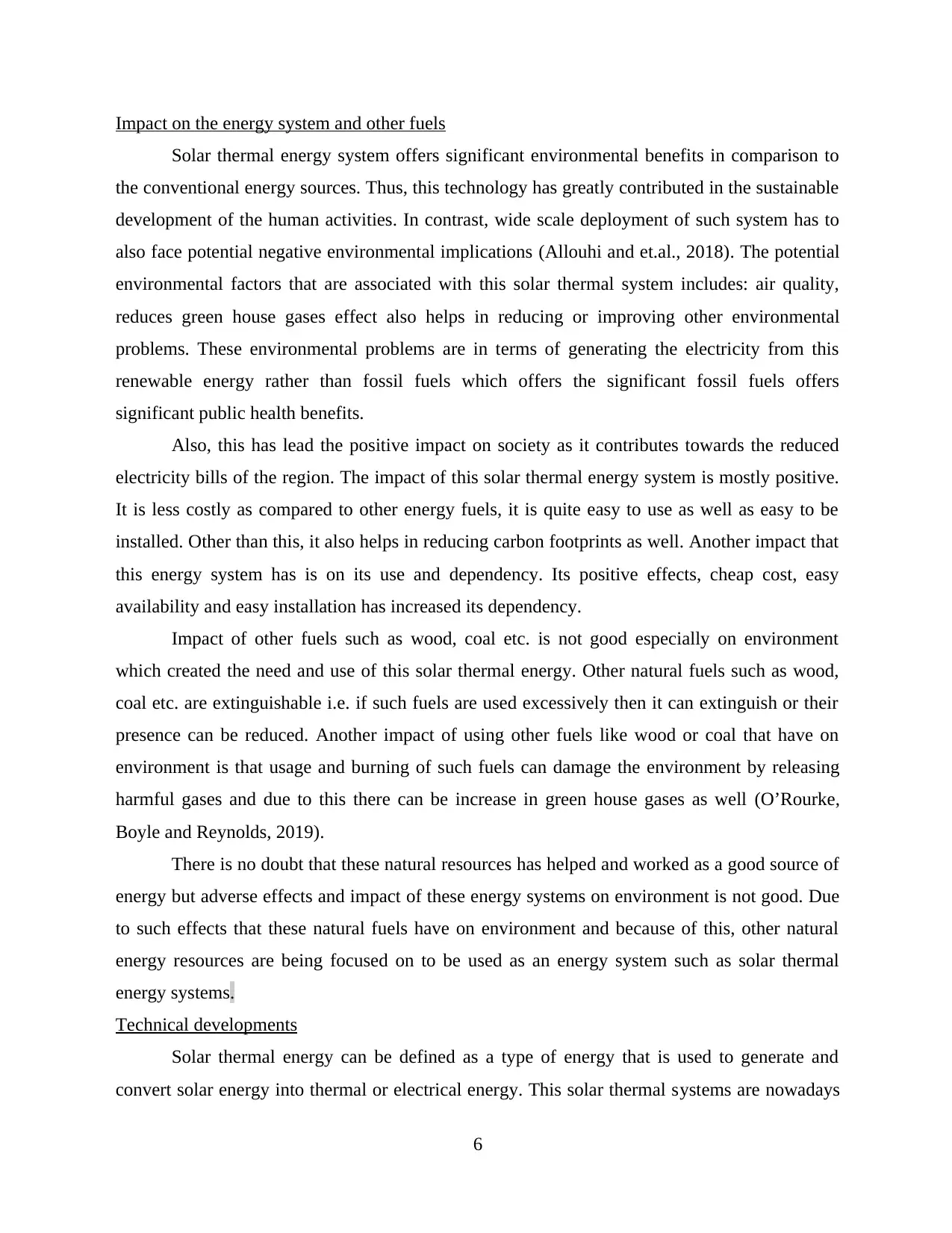
Impact on the energy system and other fuels
Solar thermal energy system offers significant environmental benefits in comparison to
the conventional energy sources. Thus, this technology has greatly contributed in the sustainable
development of the human activities. In contrast, wide scale deployment of such system has to
also face potential negative environmental implications (Allouhi and et.al., 2018). The potential
environmental factors that are associated with this solar thermal system includes: air quality,
reduces green house gases effect also helps in reducing or improving other environmental
problems. These environmental problems are in terms of generating the electricity from this
renewable energy rather than fossil fuels which offers the significant fossil fuels offers
significant public health benefits.
Also, this has lead the positive impact on society as it contributes towards the reduced
electricity bills of the region. The impact of this solar thermal energy system is mostly positive.
It is less costly as compared to other energy fuels, it is quite easy to use as well as easy to be
installed. Other than this, it also helps in reducing carbon footprints as well. Another impact that
this energy system has is on its use and dependency. Its positive effects, cheap cost, easy
availability and easy installation has increased its dependency.
Impact of other fuels such as wood, coal etc. is not good especially on environment
which created the need and use of this solar thermal energy. Other natural fuels such as wood,
coal etc. are extinguishable i.e. if such fuels are used excessively then it can extinguish or their
presence can be reduced. Another impact of using other fuels like wood or coal that have on
environment is that usage and burning of such fuels can damage the environment by releasing
harmful gases and due to this there can be increase in green house gases as well (O’Rourke,
Boyle and Reynolds, 2019).
There is no doubt that these natural resources has helped and worked as a good source of
energy but adverse effects and impact of these energy systems on environment is not good. Due
to such effects that these natural fuels have on environment and because of this, other natural
energy resources are being focused on to be used as an energy system such as solar thermal
energy systems.
Technical developments
Solar thermal energy can be defined as a type of energy that is used to generate and
convert solar energy into thermal or electrical energy. This solar thermal systems are nowadays
6
Solar thermal energy system offers significant environmental benefits in comparison to
the conventional energy sources. Thus, this technology has greatly contributed in the sustainable
development of the human activities. In contrast, wide scale deployment of such system has to
also face potential negative environmental implications (Allouhi and et.al., 2018). The potential
environmental factors that are associated with this solar thermal system includes: air quality,
reduces green house gases effect also helps in reducing or improving other environmental
problems. These environmental problems are in terms of generating the electricity from this
renewable energy rather than fossil fuels which offers the significant fossil fuels offers
significant public health benefits.
Also, this has lead the positive impact on society as it contributes towards the reduced
electricity bills of the region. The impact of this solar thermal energy system is mostly positive.
It is less costly as compared to other energy fuels, it is quite easy to use as well as easy to be
installed. Other than this, it also helps in reducing carbon footprints as well. Another impact that
this energy system has is on its use and dependency. Its positive effects, cheap cost, easy
availability and easy installation has increased its dependency.
Impact of other fuels such as wood, coal etc. is not good especially on environment
which created the need and use of this solar thermal energy. Other natural fuels such as wood,
coal etc. are extinguishable i.e. if such fuels are used excessively then it can extinguish or their
presence can be reduced. Another impact of using other fuels like wood or coal that have on
environment is that usage and burning of such fuels can damage the environment by releasing
harmful gases and due to this there can be increase in green house gases as well (O’Rourke,
Boyle and Reynolds, 2019).
There is no doubt that these natural resources has helped and worked as a good source of
energy but adverse effects and impact of these energy systems on environment is not good. Due
to such effects that these natural fuels have on environment and because of this, other natural
energy resources are being focused on to be used as an energy system such as solar thermal
energy systems.
Technical developments
Solar thermal energy can be defined as a type of energy that is used to generate and
convert solar energy into thermal or electrical energy. This solar thermal systems are nowadays
6
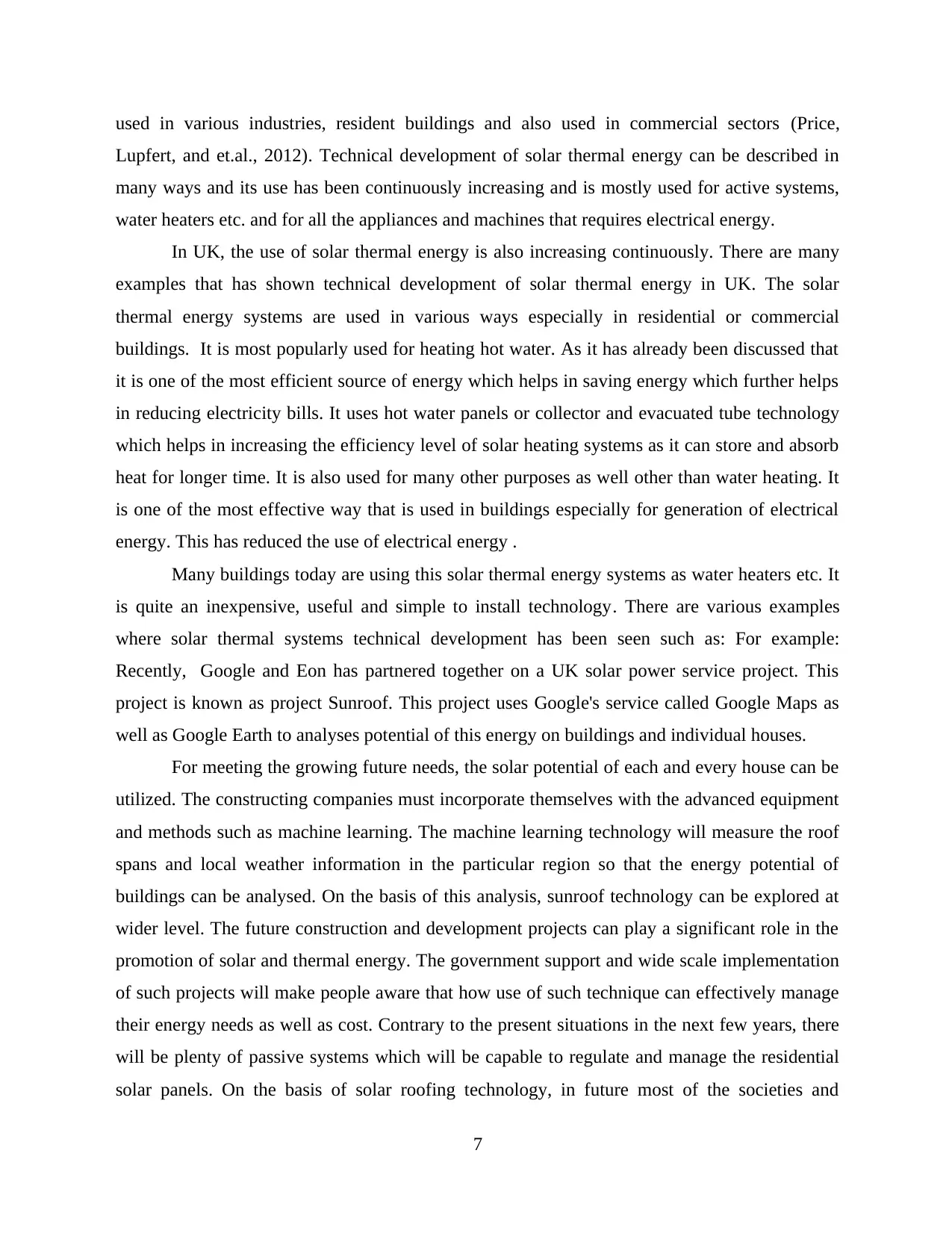
used in various industries, resident buildings and also used in commercial sectors (Price,
Lupfert, and et.al., 2012). Technical development of solar thermal energy can be described in
many ways and its use has been continuously increasing and is mostly used for active systems,
water heaters etc. and for all the appliances and machines that requires electrical energy.
In UK, the use of solar thermal energy is also increasing continuously. There are many
examples that has shown technical development of solar thermal energy in UK. The solar
thermal energy systems are used in various ways especially in residential or commercial
buildings. It is most popularly used for heating hot water. As it has already been discussed that
it is one of the most efficient source of energy which helps in saving energy which further helps
in reducing electricity bills. It uses hot water panels or collector and evacuated tube technology
which helps in increasing the efficiency level of solar heating systems as it can store and absorb
heat for longer time. It is also used for many other purposes as well other than water heating. It
is one of the most effective way that is used in buildings especially for generation of electrical
energy. This has reduced the use of electrical energy .
Many buildings today are using this solar thermal energy systems as water heaters etc. It
is quite an inexpensive, useful and simple to install technology. There are various examples
where solar thermal systems technical development has been seen such as: For example:
Recently, Google and Eon has partnered together on a UK solar power service project. This
project is known as project Sunroof. This project uses Google's service called Google Maps as
well as Google Earth to analyses potential of this energy on buildings and individual houses.
For meeting the growing future needs, the solar potential of each and every house can be
utilized. The constructing companies must incorporate themselves with the advanced equipment
and methods such as machine learning. The machine learning technology will measure the roof
spans and local weather information in the particular region so that the energy potential of
buildings can be analysed. On the basis of this analysis, sunroof technology can be explored at
wider level. The future construction and development projects can play a significant role in the
promotion of solar and thermal energy. The government support and wide scale implementation
of such projects will make people aware that how use of such technique can effectively manage
their energy needs as well as cost. Contrary to the present situations in the next few years, there
will be plenty of passive systems which will be capable to regulate and manage the residential
solar panels. On the basis of solar roofing technology, in future most of the societies and
7
Lupfert, and et.al., 2012). Technical development of solar thermal energy can be described in
many ways and its use has been continuously increasing and is mostly used for active systems,
water heaters etc. and for all the appliances and machines that requires electrical energy.
In UK, the use of solar thermal energy is also increasing continuously. There are many
examples that has shown technical development of solar thermal energy in UK. The solar
thermal energy systems are used in various ways especially in residential or commercial
buildings. It is most popularly used for heating hot water. As it has already been discussed that
it is one of the most efficient source of energy which helps in saving energy which further helps
in reducing electricity bills. It uses hot water panels or collector and evacuated tube technology
which helps in increasing the efficiency level of solar heating systems as it can store and absorb
heat for longer time. It is also used for many other purposes as well other than water heating. It
is one of the most effective way that is used in buildings especially for generation of electrical
energy. This has reduced the use of electrical energy .
Many buildings today are using this solar thermal energy systems as water heaters etc. It
is quite an inexpensive, useful and simple to install technology. There are various examples
where solar thermal systems technical development has been seen such as: For example:
Recently, Google and Eon has partnered together on a UK solar power service project. This
project is known as project Sunroof. This project uses Google's service called Google Maps as
well as Google Earth to analyses potential of this energy on buildings and individual houses.
For meeting the growing future needs, the solar potential of each and every house can be
utilized. The constructing companies must incorporate themselves with the advanced equipment
and methods such as machine learning. The machine learning technology will measure the roof
spans and local weather information in the particular region so that the energy potential of
buildings can be analysed. On the basis of this analysis, sunroof technology can be explored at
wider level. The future construction and development projects can play a significant role in the
promotion of solar and thermal energy. The government support and wide scale implementation
of such projects will make people aware that how use of such technique can effectively manage
their energy needs as well as cost. Contrary to the present situations in the next few years, there
will be plenty of passive systems which will be capable to regulate and manage the residential
solar panels. On the basis of solar roofing technology, in future most of the societies and
7
Secure Best Marks with AI Grader
Need help grading? Try our AI Grader for instant feedback on your assignments.

localities will have solar roofing representing entirely modern outlook in terms of infrastructure
and energy management (Green, 2016). The future will also be enriched with the solar theme
based industrial parks so that industrial energy needs can be meet with sustainability. Future
technical development of solar thermal technology in the future: it future it can be used for
various other purposes and can be changed into other kind of energy like chemical energy as
well. Like various companies are researching on this technology so that it can be changed into
another form of energy can be used at other places as well.
Barriers in Implementation of Solar Power in United Kingdom
The implementation of renewable energy system is highly dependent on the territorial
and environmental conditions. There are different barriers in the implementation procedure of
solar thermal system in United kingdom. The technical, social and environmental factors can
affect the efficiency and implementation of solar thermal technology. The utilization of the
solar thermal power is depended on techniques and methods which are used to obtain the power
from the solar energy.
Technological Barriers
The technological barriers in implementation of solar thermal power are based on the
technological limitation of the solar power plant. Each technology has its limited operational
area. The factors like temperature, different measures of electrical circuits can reduce the
efficiency of solar plant. The most essential thing in the solar thermal plant is utilization of the
solar power by different collecting techniques. For the collection of solar heat, different
technologies are used. The efficiency of the system is based on the selection of right method.
The different methods used to concentrate the light rays on heat collector comes with different
level of efficiency. The technology changes with change in physical condition.
The other thing which can affect the efficiency of solar thermal system is the behaviour
of electrical components at low temperature. The maximum efficiency of electronics devices is
obtained on the normal room temperature which is 27 degree Celsius. Lower temperature
conditions can reduce the efficiency of electrical circuit. The lower temperature can cause high
dissipation of heat in environment from the heat collector. The property of coolant used in the
solar system might change at low temperature. Technical barriers can either be internal or
external. Some common external technical constraints in implementation of solar thermal
technology involves vulnerability to water ingress, lack of suitable roof space, grid connection
8
and energy management (Green, 2016). The future will also be enriched with the solar theme
based industrial parks so that industrial energy needs can be meet with sustainability. Future
technical development of solar thermal technology in the future: it future it can be used for
various other purposes and can be changed into other kind of energy like chemical energy as
well. Like various companies are researching on this technology so that it can be changed into
another form of energy can be used at other places as well.
Barriers in Implementation of Solar Power in United Kingdom
The implementation of renewable energy system is highly dependent on the territorial
and environmental conditions. There are different barriers in the implementation procedure of
solar thermal system in United kingdom. The technical, social and environmental factors can
affect the efficiency and implementation of solar thermal technology. The utilization of the
solar thermal power is depended on techniques and methods which are used to obtain the power
from the solar energy.
Technological Barriers
The technological barriers in implementation of solar thermal power are based on the
technological limitation of the solar power plant. Each technology has its limited operational
area. The factors like temperature, different measures of electrical circuits can reduce the
efficiency of solar plant. The most essential thing in the solar thermal plant is utilization of the
solar power by different collecting techniques. For the collection of solar heat, different
technologies are used. The efficiency of the system is based on the selection of right method.
The different methods used to concentrate the light rays on heat collector comes with different
level of efficiency. The technology changes with change in physical condition.
The other thing which can affect the efficiency of solar thermal system is the behaviour
of electrical components at low temperature. The maximum efficiency of electronics devices is
obtained on the normal room temperature which is 27 degree Celsius. Lower temperature
conditions can reduce the efficiency of electrical circuit. The lower temperature can cause high
dissipation of heat in environment from the heat collector. The property of coolant used in the
solar system might change at low temperature. Technical barriers can either be internal or
external. Some common external technical constraints in implementation of solar thermal
technology involves vulnerability to water ingress, lack of suitable roof space, grid connection
8
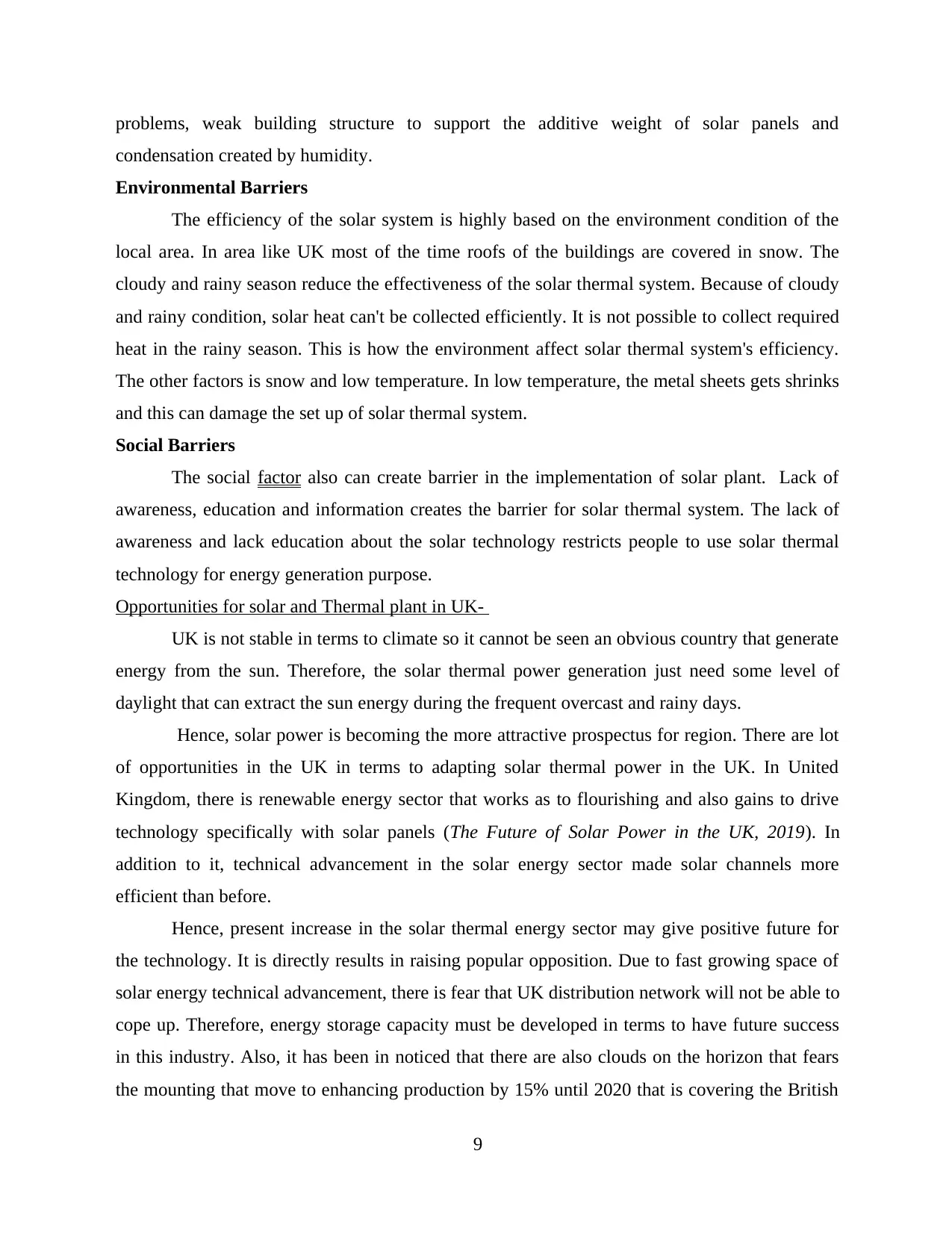
problems, weak building structure to support the additive weight of solar panels and
condensation created by humidity.
Environmental Barriers
The efficiency of the solar system is highly based on the environment condition of the
local area. In area like UK most of the time roofs of the buildings are covered in snow. The
cloudy and rainy season reduce the effectiveness of the solar thermal system. Because of cloudy
and rainy condition, solar heat can't be collected efficiently. It is not possible to collect required
heat in the rainy season. This is how the environment affect solar thermal system's efficiency.
The other factors is snow and low temperature. In low temperature, the metal sheets gets shrinks
and this can damage the set up of solar thermal system.
Social Barriers
The social factor also can create barrier in the implementation of solar plant. Lack of
awareness, education and information creates the barrier for solar thermal system. The lack of
awareness and lack education about the solar technology restricts people to use solar thermal
technology for energy generation purpose.
Opportunities for solar and Thermal plant in UK-
UK is not stable in terms to climate so it cannot be seen an obvious country that generate
energy from the sun. Therefore, the solar thermal power generation just need some level of
daylight that can extract the sun energy during the frequent overcast and rainy days.
Hence, solar power is becoming the more attractive prospectus for region. There are lot
of opportunities in the UK in terms to adapting solar thermal power in the UK. In United
Kingdom, there is renewable energy sector that works as to flourishing and also gains to drive
technology specifically with solar panels (The Future of Solar Power in the UK, 2019). In
addition to it, technical advancement in the solar energy sector made solar channels more
efficient than before.
Hence, present increase in the solar thermal energy sector may give positive future for
the technology. It is directly results in raising popular opposition. Due to fast growing space of
solar energy technical advancement, there is fear that UK distribution network will not be able to
cope up. Therefore, energy storage capacity must be developed in terms to have future success
in this industry. Also, it has been in noticed that there are also clouds on the horizon that fears
the mounting that move to enhancing production by 15% until 2020 that is covering the British
9
condensation created by humidity.
Environmental Barriers
The efficiency of the solar system is highly based on the environment condition of the
local area. In area like UK most of the time roofs of the buildings are covered in snow. The
cloudy and rainy season reduce the effectiveness of the solar thermal system. Because of cloudy
and rainy condition, solar heat can't be collected efficiently. It is not possible to collect required
heat in the rainy season. This is how the environment affect solar thermal system's efficiency.
The other factors is snow and low temperature. In low temperature, the metal sheets gets shrinks
and this can damage the set up of solar thermal system.
Social Barriers
The social factor also can create barrier in the implementation of solar plant. Lack of
awareness, education and information creates the barrier for solar thermal system. The lack of
awareness and lack education about the solar technology restricts people to use solar thermal
technology for energy generation purpose.
Opportunities for solar and Thermal plant in UK-
UK is not stable in terms to climate so it cannot be seen an obvious country that generate
energy from the sun. Therefore, the solar thermal power generation just need some level of
daylight that can extract the sun energy during the frequent overcast and rainy days.
Hence, solar power is becoming the more attractive prospectus for region. There are lot
of opportunities in the UK in terms to adapting solar thermal power in the UK. In United
Kingdom, there is renewable energy sector that works as to flourishing and also gains to drive
technology specifically with solar panels (The Future of Solar Power in the UK, 2019). In
addition to it, technical advancement in the solar energy sector made solar channels more
efficient than before.
Hence, present increase in the solar thermal energy sector may give positive future for
the technology. It is directly results in raising popular opposition. Due to fast growing space of
solar energy technical advancement, there is fear that UK distribution network will not be able to
cope up. Therefore, energy storage capacity must be developed in terms to have future success
in this industry. Also, it has been in noticed that there are also clouds on the horizon that fears
the mounting that move to enhancing production by 15% until 2020 that is covering the British
9
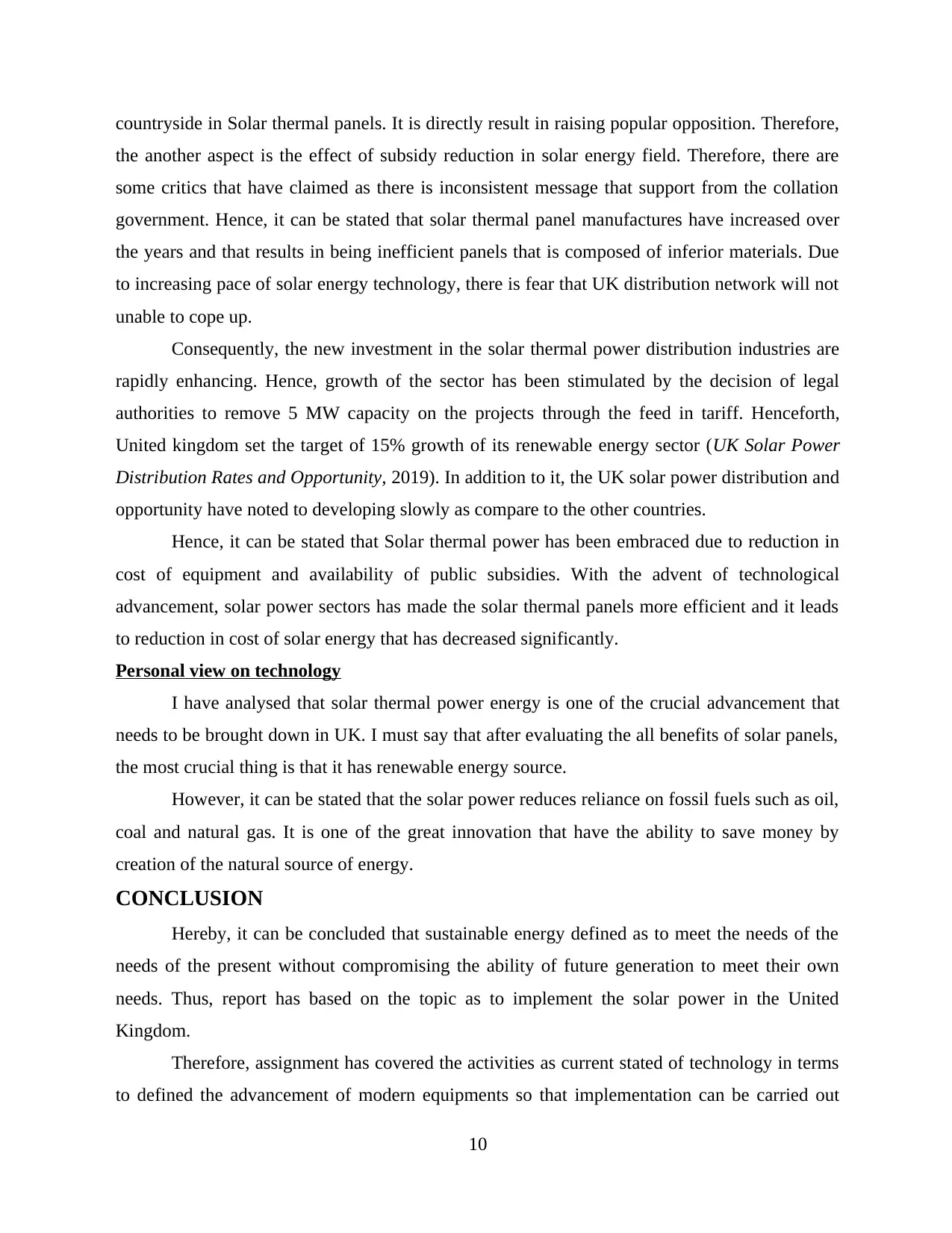
countryside in Solar thermal panels. It is directly result in raising popular opposition. Therefore,
the another aspect is the effect of subsidy reduction in solar energy field. Therefore, there are
some critics that have claimed as there is inconsistent message that support from the collation
government. Hence, it can be stated that solar thermal panel manufactures have increased over
the years and that results in being inefficient panels that is composed of inferior materials. Due
to increasing pace of solar energy technology, there is fear that UK distribution network will not
unable to cope up.
Consequently, the new investment in the solar thermal power distribution industries are
rapidly enhancing. Hence, growth of the sector has been stimulated by the decision of legal
authorities to remove 5 MW capacity on the projects through the feed in tariff. Henceforth,
United kingdom set the target of 15% growth of its renewable energy sector (UK Solar Power
Distribution Rates and Opportunity, 2019). In addition to it, the UK solar power distribution and
opportunity have noted to developing slowly as compare to the other countries.
Hence, it can be stated that Solar thermal power has been embraced due to reduction in
cost of equipment and availability of public subsidies. With the advent of technological
advancement, solar power sectors has made the solar thermal panels more efficient and it leads
to reduction in cost of solar energy that has decreased significantly.
Personal view on technology
I have analysed that solar thermal power energy is one of the crucial advancement that
needs to be brought down in UK. I must say that after evaluating the all benefits of solar panels,
the most crucial thing is that it has renewable energy source.
However, it can be stated that the solar power reduces reliance on fossil fuels such as oil,
coal and natural gas. It is one of the great innovation that have the ability to save money by
creation of the natural source of energy.
CONCLUSION
Hereby, it can be concluded that sustainable energy defined as to meet the needs of the
needs of the present without compromising the ability of future generation to meet their own
needs. Thus, report has based on the topic as to implement the solar power in the United
Kingdom.
Therefore, assignment has covered the activities as current stated of technology in terms
to defined the advancement of modern equipments so that implementation can be carried out
10
the another aspect is the effect of subsidy reduction in solar energy field. Therefore, there are
some critics that have claimed as there is inconsistent message that support from the collation
government. Hence, it can be stated that solar thermal panel manufactures have increased over
the years and that results in being inefficient panels that is composed of inferior materials. Due
to increasing pace of solar energy technology, there is fear that UK distribution network will not
unable to cope up.
Consequently, the new investment in the solar thermal power distribution industries are
rapidly enhancing. Hence, growth of the sector has been stimulated by the decision of legal
authorities to remove 5 MW capacity on the projects through the feed in tariff. Henceforth,
United kingdom set the target of 15% growth of its renewable energy sector (UK Solar Power
Distribution Rates and Opportunity, 2019). In addition to it, the UK solar power distribution and
opportunity have noted to developing slowly as compare to the other countries.
Hence, it can be stated that Solar thermal power has been embraced due to reduction in
cost of equipment and availability of public subsidies. With the advent of technological
advancement, solar power sectors has made the solar thermal panels more efficient and it leads
to reduction in cost of solar energy that has decreased significantly.
Personal view on technology
I have analysed that solar thermal power energy is one of the crucial advancement that
needs to be brought down in UK. I must say that after evaluating the all benefits of solar panels,
the most crucial thing is that it has renewable energy source.
However, it can be stated that the solar power reduces reliance on fossil fuels such as oil,
coal and natural gas. It is one of the great innovation that have the ability to save money by
creation of the natural source of energy.
CONCLUSION
Hereby, it can be concluded that sustainable energy defined as to meet the needs of the
needs of the present without compromising the ability of future generation to meet their own
needs. Thus, report has based on the topic as to implement the solar power in the United
Kingdom.
Therefore, assignment has covered the activities as current stated of technology in terms
to defined the advancement of modern equipments so that implementation can be carried out
10
Paraphrase This Document
Need a fresh take? Get an instant paraphrase of this document with our AI Paraphraser

successfully. Lastly, barriers and opportunities relates with solar power has defined to determine
the future growth within the market of the UK.
11
the future growth within the market of the UK.
11
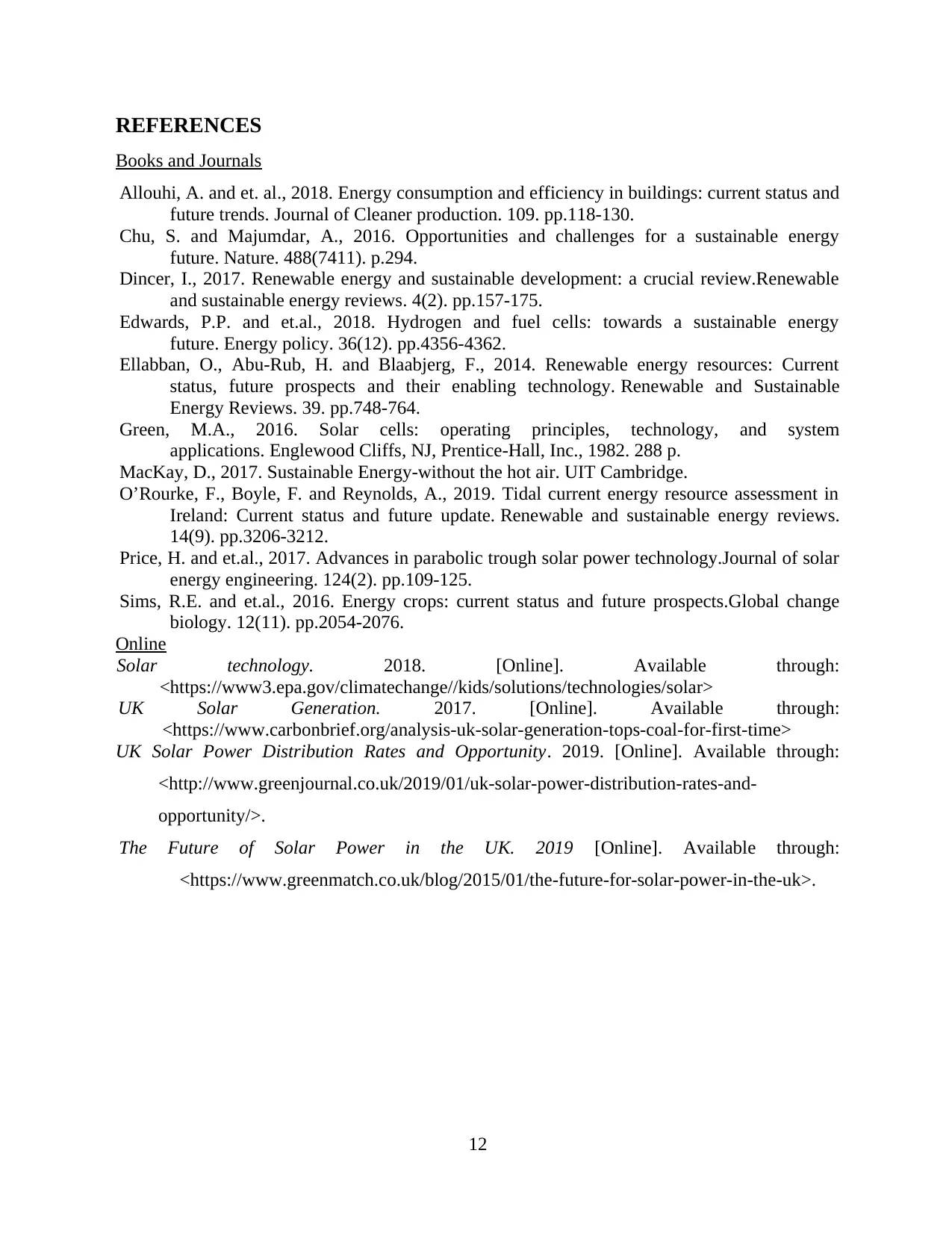
REFERENCES
Books and Journals
Allouhi, A. and et. al., 2018. Energy consumption and efficiency in buildings: current status and
future trends. Journal of Cleaner production. 109. pp.118-130.
Chu, S. and Majumdar, A., 2016. Opportunities and challenges for a sustainable energy
future. Nature. 488(7411). p.294.
Dincer, I., 2017. Renewable energy and sustainable development: a crucial review.Renewable
and sustainable energy reviews. 4(2). pp.157-175.
Edwards, P.P. and et.al., 2018. Hydrogen and fuel cells: towards a sustainable energy
future. Energy policy. 36(12). pp.4356-4362.
Ellabban, O., Abu-Rub, H. and Blaabjerg, F., 2014. Renewable energy resources: Current
status, future prospects and their enabling technology. Renewable and Sustainable
Energy Reviews. 39. pp.748-764.
Green, M.A., 2016. Solar cells: operating principles, technology, and system
applications. Englewood Cliffs, NJ, Prentice-Hall, Inc., 1982. 288 p.
MacKay, D., 2017. Sustainable Energy-without the hot air. UIT Cambridge.
O’Rourke, F., Boyle, F. and Reynolds, A., 2019. Tidal current energy resource assessment in
Ireland: Current status and future update. Renewable and sustainable energy reviews.
14(9). pp.3206-3212.
Price, H. and et.al., 2017. Advances in parabolic trough solar power technology.Journal of solar
energy engineering. 124(2). pp.109-125.
Sims, R.E. and et.al., 2016. Energy crops: current status and future prospects.Global change
biology. 12(11). pp.2054-2076.
Online
Solar technology. 2018. [Online]. Available through:
<https://www3.epa.gov/climatechange//kids/solutions/technologies/solar>
UK Solar Generation. 2017. [Online]. Available through:
<https://www.carbonbrief.org/analysis-uk-solar-generation-tops-coal-for-first-time>
UK Solar Power Distribution Rates and Opportunity. 2019. [Online]. Available through:
<http://www.greenjournal.co.uk/2019/01/uk-solar-power-distribution-rates-and-
opportunity/>.
The Future of Solar Power in the UK. 2019 [Online]. Available through:
<https://www.greenmatch.co.uk/blog/2015/01/the-future-for-solar-power-in-the-uk>.
12
Books and Journals
Allouhi, A. and et. al., 2018. Energy consumption and efficiency in buildings: current status and
future trends. Journal of Cleaner production. 109. pp.118-130.
Chu, S. and Majumdar, A., 2016. Opportunities and challenges for a sustainable energy
future. Nature. 488(7411). p.294.
Dincer, I., 2017. Renewable energy and sustainable development: a crucial review.Renewable
and sustainable energy reviews. 4(2). pp.157-175.
Edwards, P.P. and et.al., 2018. Hydrogen and fuel cells: towards a sustainable energy
future. Energy policy. 36(12). pp.4356-4362.
Ellabban, O., Abu-Rub, H. and Blaabjerg, F., 2014. Renewable energy resources: Current
status, future prospects and their enabling technology. Renewable and Sustainable
Energy Reviews. 39. pp.748-764.
Green, M.A., 2016. Solar cells: operating principles, technology, and system
applications. Englewood Cliffs, NJ, Prentice-Hall, Inc., 1982. 288 p.
MacKay, D., 2017. Sustainable Energy-without the hot air. UIT Cambridge.
O’Rourke, F., Boyle, F. and Reynolds, A., 2019. Tidal current energy resource assessment in
Ireland: Current status and future update. Renewable and sustainable energy reviews.
14(9). pp.3206-3212.
Price, H. and et.al., 2017. Advances in parabolic trough solar power technology.Journal of solar
energy engineering. 124(2). pp.109-125.
Sims, R.E. and et.al., 2016. Energy crops: current status and future prospects.Global change
biology. 12(11). pp.2054-2076.
Online
Solar technology. 2018. [Online]. Available through:
<https://www3.epa.gov/climatechange//kids/solutions/technologies/solar>
UK Solar Generation. 2017. [Online]. Available through:
<https://www.carbonbrief.org/analysis-uk-solar-generation-tops-coal-for-first-time>
UK Solar Power Distribution Rates and Opportunity. 2019. [Online]. Available through:
<http://www.greenjournal.co.uk/2019/01/uk-solar-power-distribution-rates-and-
opportunity/>.
The Future of Solar Power in the UK. 2019 [Online]. Available through:
<https://www.greenmatch.co.uk/blog/2015/01/the-future-for-solar-power-in-the-uk>.
12
1 out of 15
Related Documents
Your All-in-One AI-Powered Toolkit for Academic Success.
+13062052269
info@desklib.com
Available 24*7 on WhatsApp / Email
![[object Object]](/_next/static/media/star-bottom.7253800d.svg)
Unlock your academic potential
© 2024 | Zucol Services PVT LTD | All rights reserved.





